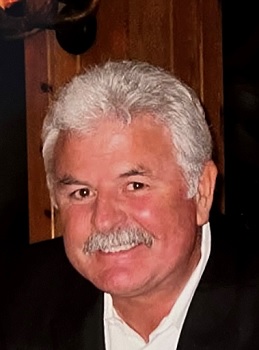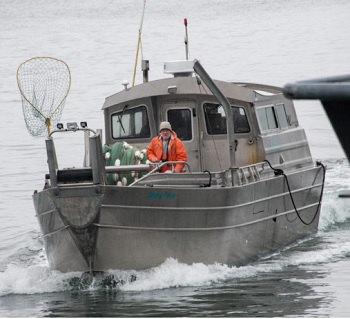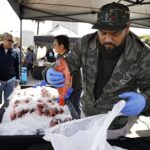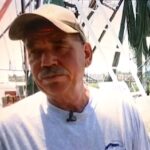Tag Archives: International Pacific Halibut Commission

Alaska Halibut Season Opens March 10
Pacific halibut season opens Sunday, March 10 statewide in Alaska. NOAA Fisheries filed notice of their effectiveness in the Federal Register today, which will publish March 7, 2023. The regulations, adopted at the annual meeting of the International Pacific Halibut Commission (IPHC) in January, took effect when the Secretary of State accepted them, with the Secretary of Commerce’s concurrence. Included in this season’s federal regulations are the catch limits established by the IPHC and basic regulations for the commercial and sport halibut fisheries. >click to read< 18:03

Commission cuts halibut limits across Alaska, Canada
The International Pacific Halibut Commission adopted its annual catch limits for halibut in 2023 from California to the Bering Sea at its meeting Jan. 27. Coastwide, the total constant exploitation yield, a term for how many total halibut longer than 26 inches are removed from the population, regardless of reason, is just shy of 37 million pounds, a 10% drop from 41.2 million pounds last year. Every regulatory area received a cut except for 2A, which covers California, Oregon and Washington. Area 3A, which covers the central Gulf of Alaska, and area 4A, which covers the eastern Aleutians, saw the largest cuts at 17% each. Southeast Alaska only saw a 1% cut, while the western Gulf, western Aleutians and central Bering Sea each saw 6% cuts. The Canadian coast saw a 10.3% cut. >click to read< 11:50

Commission releases halibut quotas
The International Pacific Halibut Commission has released the quotas for the 2023 season, and they seem to be more aligned with reality than the increases the past two years, with the IPHC describing the overall biomass as being at “historic lows.” Quotas are down across the board in Alaska and Canada, especially in Areas 3A and 4A. Area 2B, British Columbia, also took a hit, with a quota of 5.03 million pounds, down 11.75%. Fishermen are becoming distrustful in the IPHC process, according to fisherman and fisheries advocate Buck Laukitis. “The IPHC management process is more political than science-based,” he said via text. “Long-time fishermen and those interested in having something to catch a generation from now are losing confidence in an overly complicated and very political process.” >click to read< 18:11

Fish Wholesaler/Processor Dana F. Besecker of Bellevue, Washington has passed away
Dana F. Besecker, a beloved husband, father, grandfather, and friend passed away peacefully with his wife Jill and sons Jeff and Tyler by his side due to complications from Parkinson’s disease. He founded the Dana F. Besecker Company in 1989 which is located on Mercer Island, WA with additional offices in Bellingham, WA. As a fish wholesaler and processor, his company buys seafood from fishermen in Alaska, Washington, Oregon, California, and Canada. His company now sells seafood in 58 countries. He was well-known and highly respected within the industry as a leader, innovative businessman and mentor to many, as well as an honest professional–his word was his bond! Dana was a trustee of Halibut Association of North America, a sponsor and longtime supporter of Fishing Vessel Owner’s Association, and an active participant in the International Pacific Halibut Commission. >click to read< 11:30

British Columbia: Hooked on halibut: For many commercial fishers, it’s a family affair
The commercial halibut season is underway along the coast of British Columbia and boats are already starting to deliver the flat fish to dinner plates. From now until early December, the B.C. halibut fleet will haul in an estimated 5.7 million pounds of halibut. The Americans will take the lion’s share of this year’s 41-million-pound total allowable catch, nearly 80%, because their territory stretches over California, Oregon, Washington and all of Alaska to the tip of the Aleutian Islands and covers nine of the 10 designated halibut-fishing areas along the Pacific Coast. Tiare Boyes and Cheri Hansen weigh in on what it’s like to work on the water during the halibut fishing season. Photos, >click to read< 11:14

NPFMC ponders changes in the halibut catch sharing plan
When the North Pacific Fishery Management Council adopted its halibut Catch Share Plan back 2014, charter operators were granted 125% of their historic catch at low levels of abundance, with that additional 25% coming out of quota for the commercial longline sector. Commercial longliners were assured that no further uncompensated reallocations would be considered, but now federal fisheries managers are doing just that. The Halibut Coalition is urging its membership of commercial harvesters to write to the governors of Alaska, Washington and Oregon expressing their views, as the representatives of those states on the NPFMC voted in favor of considering changes to halibut allocations. >click to read< 13:41

International Pacific Halibut commission raises most Alaska harvest limits for 2022
An uptick in halibut stocks along much of the Pacific coast means increases in total catch limits in every region of Alaska this year. The International Pacific Halibut Commission decided in its annual meeting last week to increase catch limits in every management region except for 2A, which covers the California, Oregon, and Washington coast, with an overall coastwide increase of nearly 6%. The increase comes after IPHC researchers informed the commission that halibut stocks were showing signs of rebounding from lows in the last five years, in part due to a large age class from 2012 becoming mature. The long-term trends of decline seemed to end in 2013, when the stocks began to climb again. >click to read< 14:37

NPFMC ties limits on Bering Sea trawlers to halibut abundance
The council that manages fishing in federal waters voted to link groundfish trawl fishing in the Bering Sea and Aleutian Islands to halibut abundance today. The action caps, at least for now, a six-year debate about curbing halibut bycatch in Alaska. For many who have been following that debate, the decision comes as a surprise, since it’s expected to deal what trawlers say is a crushing blow to their fishery. >click to read< 09:10

NPFMC meets online to resolve halibut issues
Federal fisheries managers met online in mid-May to approve emergency action necessitated by the impact of the novel coronavirus,, The session, announced in late April, allowed for harvests, processors and other fishing industry entities until one day in advance of the May 15 meeting to submit written comments through links on the North Pacific Fishery Management Council’s agenda on five emergency requests. Those requests ranged from allowing all holders of individual fishing quota to make temporary transfers of that quota to eligible hired masters during the pandemic to increasing IFQ end-of-year rollover provisions. The council approved the transfer for the rest of the 2020 season for quota shares owned by all halibut and sablefish IFQ holders, based on a request from 11 industry leaders. The council also recommended to the International Pacific Halibut Commission, a request from the halibut charter industry,,,>click to read< 18:34

Central Gulf of Alaska halibut catch limit cut
Halibut catch limits for 2020 have been trimmed overall by seven percent by the International Pacific Halibut Commission, with the Central Gulf of Alaska, Area 3A, allocated a harvest of 7.05 million pounds, down 12.53 percent from 8.06 million pounds in 2019. The largest area percentage cut was for Area CDE, the Bering Sea, where the quota was cut 15.20 percent, from 2.04 million pounds to 1.73 million pounds. Area 4A, in the Aleutians, likewise received a 14.55 percent cut, from 1.65 million pounds in 2019 to 1.41 million pounds for 2020. >click to read< 12:03

International Pacific Halibut Commission cuts 2020 harvest levels for US waters
Amid ongoing stock declines and concerns about commercial bycatch, the International Pacific Halibut Commission opted to cut allocations in Southcentral and Southeast Alaska for 2020.,, U.S. Commissioner Chris Oliver said he recognized that there maybe some dissatisfaction on the U.S. side,, Canadian Commissioner Peter DeGreef said he objected to the level of fishing intensity as well, saying that without a cut,,, >click to read< 10:06

DNA tests show commercial halibut catch 90% female, influencing catch limits being set this week
For the first time in its 96 year history, the International Pacific Halibut Commission will be setting catch limits for halibut this week with the knowledge that the commercial fleet’s catch has been around 90 percent female, a notably higher proportion than previously thought. “The Commission has long known that the directed commercial Pacific halibut fishery catches mostly female, but we’ve had indications,,, >click to read< 18:59

Uneven status of Pacific halibut revealed by annual data
Following the trend of the past several years, overall Pacific halibut biomass seems to be down again. The most recent stock assessment presented to the International Pacific Halibut Commission for its interim meeting on Nov. 25-26 shows a coastwide decline in spawning biomass, though that decline isn’t even across all areas. That’s a continuation of a trend seen in stock assessments since 2015. Particularly, surveys have indicated lower numbers of halibut in the central Gulf of Alaska. >click to read< 08:40

US, Canada agree on 2019 halibut harvest limits
American and Canadian halibut fishermen finally have an approved set of catch limits for the 2019 season. With the discord of its last annual meeting hanging in the air, the International Pacific Halibut Commission agreed on a set of total allowable catch limits for Pacific halibut in American and Canadian waters during its meeting from Jan. 28 to Feb. 1. The overall catch limit of 38.61 million pounds is slightly up from the 2018 quota — about 1.4 million pounds more. That’s up from 29.9 million pounds in 2016 and from 31.4 million pounds in 2017.,,, >click to read<20:45

Year in Review: A dismal year for salmon and halibut in the Gulf, Bristol Bay booms, battles over hatcheries
This summer was a disappointment for salmon fishermen across the Gulf of Alaska, both in the timing and in the numbers. Salmon fishermen from Kodiak to Southeast saw poor harvests and poor profits this year due to unexpectedly small runs of sockeye, king and pink salmon. No. 2: Records smashed in Bristol Bay, Norton Sound, No. 3: Hatchery battles at the Board of Fisheries, No. 4: Halibut hardships, falling quotas and prices, >click to read<11:35

Survey again shows drop in halibut stocks in Gulf of Alaska
The 2018 stock status report presented to the International Pacific Halibut Commission at its interim meeting on Nov. 27 shows yet another drop in the biomass of Pacific halibut in the North Pacific — about 7 percent down from the 2017 fishery-independent setline survey. That doesn’t mean every single region dropped, as it’s an average, but Alaska’s three main areas of effort — 2C, the entirety of Region 3, and Region 4 excluding the western Aleutian Islands — all dropped. The most significant drop was in Area 2, which stretches from northern California to Southeast, falling 15 percent. Region 3, which stretches across the Gulf of Alaska out to the Alaska Peninsula, fell 7 percent. >click to read<20:19

Final harvest numbers in hand, halibut commission set for meeting
All of Alaska’s Pacific halibut fisheries stayed within their quota limits this year, but not all individual sectors within the fishery areas did. The final regular landings update for 2018 from the International Pacific Halibut Commission, issued Nov. 15, outlines the final data available before the first interim meeting of the commission. Overall, all Pacific halibut fisheries for Canada and the U.S. harvested about 26.5 million pounds of halibut, or about 95 percent of the total limit of 27.9 million pounds. >click to read<15:15

Charges filed in high-grading case against Ilwaco charter skippers
Several local charter skippers and crewmen could soon be reeling in hefty fines and jail sentences. Following a nine-month Washington Department of Fish and Wildlife investigation, the state in early April filed a total of 37 criminal charges against six men affiliated with Pacific Salmon Charters: David Gudgell, 57, of Seaview; Robert Gudgell, 56, of Longview; Thomas Merriman, 61, of Sammamish; Brian Cables, 59, of Ilwaco; Patrick Gore, 28, of Deer Island, Ore.; and Richard Mercado, 52, of Tacoma. Investigators say the men systematically urged,,, >click to read<14:55

IPHC commissioners hope to find middle ground on catch limits
In January, disagreements on the International Pacific Halibut Commission came to a head. U.S. and Canadian commissioners are in agreement on one thing, halibut stocks are on the decline. But when it came to divvying up the catch between U.S. and Canadian waters, commissioners were at an impasse. The fundamental disagreement comes down to whether halibut should be allocated solely based on the science or if social and economic considerations should also play a role. Next month commissioners will begin that conversation. >click to read<11:54

Halibut quotas for 2018 come in slightly lower than expected
The total allowable catch for the 2018 Pacific halibut season in the Gulf of Alaska and Southeast will be set slightly lower than what U.S. commissioners on the International Pacific Halibut Commission had asked for. The National Oceanic and Atmospheric Administration will publish a final rule in the Federal Register Tuesday setting combined charter and commercial quotas in Southeast, area 2C, at 4.4 million pounds. That’s about a 17-percent drop from the total allowable catch in 2017. >click to read<17:39

Halibut fishery poised to open as NMFS works on 2018 catch limits
Alaska’s halibut fishery is set to open this month, but the final quota was still not completely set as of March 14, even as fishermen began to receive permits in the mail. Indications, however, are that the quota will decrease this year compared to last. Under regulations published by the National Marine Fisheries Service this month, the fishery will open March 24 and run through Nov. 7. But the total catch limits remain unknown. That’s because this year, for just the second time in the commission’s history that dates to its creation by a 1923 treaty, the International Pacific Halibut Commission could not come to an agreement about the 2018 catch limits at its annual meeting. >click to read<12:36

Kodiak fishermen find extra work through halibut research amid stock concern
The Pacific halibut fishery may see a drop in stock over the next few years and the International Pacific Halibut Commission, which regulates the fishery, uses surveys in Kodiak waters to collect data.The surveys also give local fishermen another job to tackle during the winter season, especially with the recent announcement of the 80 percent cut to Pacific cod quota in 2018. click here to read the story 23:10

A tricky break for business fishermen: Pacific halibut catches more likely to drop subsequent 12 months
It‘s going to be a tough year for many Alaska fishermen. After announcements of a massive drop in cod stocks, the industry learned last week that Pacific halibut catches are likely to drop by 20 percent next year, and the declines could continue for several years. That could bring the coastwide catch for 2018, meaning from Oregon to British Columbia to the Bering Sea, to about 31 million pounds. Scientists at the International Pacific Halibut Commission interim meeting in Seattle revealed that survey results showed halibut numbers were down,,, click here to read the story 09:57

Pacific Halibut numbers could drop
Scientists monitoring halibut say there could be a decline in the bottom fish along the coast of the U.S. and Canada in upcoming years if the current level of fishing continues. The International Pacific Halibut Commission oversees management of the fish along the coast from Alaska to California. Commissioners had an interim meeting Tuesday and Wednesday, November 28-29th in Seattle and heard about this year’s catch and the latest estimates of halibut stocks. Scientists found fewer younger halibut in survey fishing done up and down the coast this year. click here to read the story 16:10
International Pacific Halibut Commission to revisit minimum size limit
 The International Pacific Halibut Commission, which regulates halibut fisheries in U.S. and Canadian waters, is set to take a fresh look at the minimum size limit during its meeting cycle this winter. The current limit allows commercial fishermen to retain fish larger than 32 inches, but the size of mature halibut has been shrinking over the years, which has some wondering whether the limit should be reduced or removed altogether. click here to read the story 09:16
The International Pacific Halibut Commission, which regulates halibut fisheries in U.S. and Canadian waters, is set to take a fresh look at the minimum size limit during its meeting cycle this winter. The current limit allows commercial fishermen to retain fish larger than 32 inches, but the size of mature halibut has been shrinking over the years, which has some wondering whether the limit should be reduced or removed altogether. click here to read the story 09:16
Commercial longline seasons to open March 11th, on time
 Commercial longliners in Alaska can go fishing on March 11 after all. The National Marine Fisheries Service announced Friday. March 3 that March 11th will be the start date for halibut and black cod fishing. March 11th is the halibut fishing start date approved by the International Pacific Halibut Commission back in January. The National Marine Fisheries Service typically opens long-line fishing for black cod on the same day. President Trump issued an executive order in January requiring that for every one new regulation issued, at least two prior regulations be identified for elimination. The start dates, catch share plan and other changes are all regulations that need to be published in the federal register. As of late last month, the National Marine Fisheries Service was still unsure of the impact of the presidential order on the fisheries. Fishermen in Alaska were questioning whether they’d be able to start fishing on that date. However, the federal agency confirmed Friday that the season would be starting on the 11th for both halibut and black cod. Read the rest here 08:52
Commercial longliners in Alaska can go fishing on March 11 after all. The National Marine Fisheries Service announced Friday. March 3 that March 11th will be the start date for halibut and black cod fishing. March 11th is the halibut fishing start date approved by the International Pacific Halibut Commission back in January. The National Marine Fisheries Service typically opens long-line fishing for black cod on the same day. President Trump issued an executive order in January requiring that for every one new regulation issued, at least two prior regulations be identified for elimination. The start dates, catch share plan and other changes are all regulations that need to be published in the federal register. As of late last month, the National Marine Fisheries Service was still unsure of the impact of the presidential order on the fisheries. Fishermen in Alaska were questioning whether they’d be able to start fishing on that date. However, the federal agency confirmed Friday that the season would be starting on the 11th for both halibut and black cod. Read the rest here 08:52
International Pacific Halibut Commission approves increases in halibut catch limits
 Most parts of the Pacific coastline will see an increase in commercial and charter fishing catch limits for halibut this year. The International Pacific Halibut Commission Friday approved a coast-wide catch limit of 31.4 million pounds of the valuable bottom fish. That’s an increase from just under 30 million pounds last year. Several parts of the coast were facing catch limit cuts based on alternatives presented by IPHC scientists. However, commissioners voted to boost harvest limits instead of making reductions. There was some disagreement about the BC catch limit this year. Listen to the audio report or read it here 19:11
Most parts of the Pacific coastline will see an increase in commercial and charter fishing catch limits for halibut this year. The International Pacific Halibut Commission Friday approved a coast-wide catch limit of 31.4 million pounds of the valuable bottom fish. That’s an increase from just under 30 million pounds last year. Several parts of the coast were facing catch limit cuts based on alternatives presented by IPHC scientists. However, commissioners voted to boost harvest limits instead of making reductions. There was some disagreement about the BC catch limit this year. Listen to the audio report or read it here 19:11

The International Pacific Halibut Commission meeting is underway in BC
The International Pacific Halibut Commission will be deciding on catch limits, other proposed changes to management and season length though Friday in Victoria, British Columbia. “The way we apportion the resource it’s been probably the subject of the most dissatisfaction on the U.S. side over the past couple of years,” said U.S. commissioner and vice-chair Jim Balsiger at the start of the meeting Monday. “All the commissioners I believe on both sides are anxious to come to grips with that, find a harvest policy and apportionment method that works for everybody that we can explain to the people who use the resource and make some progress on that.” Read the story here For agenda details of the meeting and link to the webinar, click here 10:40

2017 IPHC Annual Meeting Monday, January 23 through Friday, January 27, 2017 in Victoria, British Columbia
The Ninety-third Annual Meeting of the International Pacific Halibut Commission will be held from Monday, January 23 through Friday, January 27, 2017 in Victoria, British Columbia at the Delta Hotels Victoria Ocean Pointe Resort. Further details on the 2017 IPHC Annual Meeting














































PFMC plans transition for non-Indian commercial Area 2A halibut fishery; new season-setting process begins
The Pacific Fishery Management Council is requesting public comment on structuring the West Coast Area 2A non-Indian directed commercial halibut fishery for the upcoming year. The public is encouraged to comment at the September and November council meetings as management of this halibut fishery transitions from the International Pacific Halibut Commission, or IPHC, to the council. In June, the council committed to working closely with the IPHC and stakeholders on the transition. >click to read< 21:45
Share this post